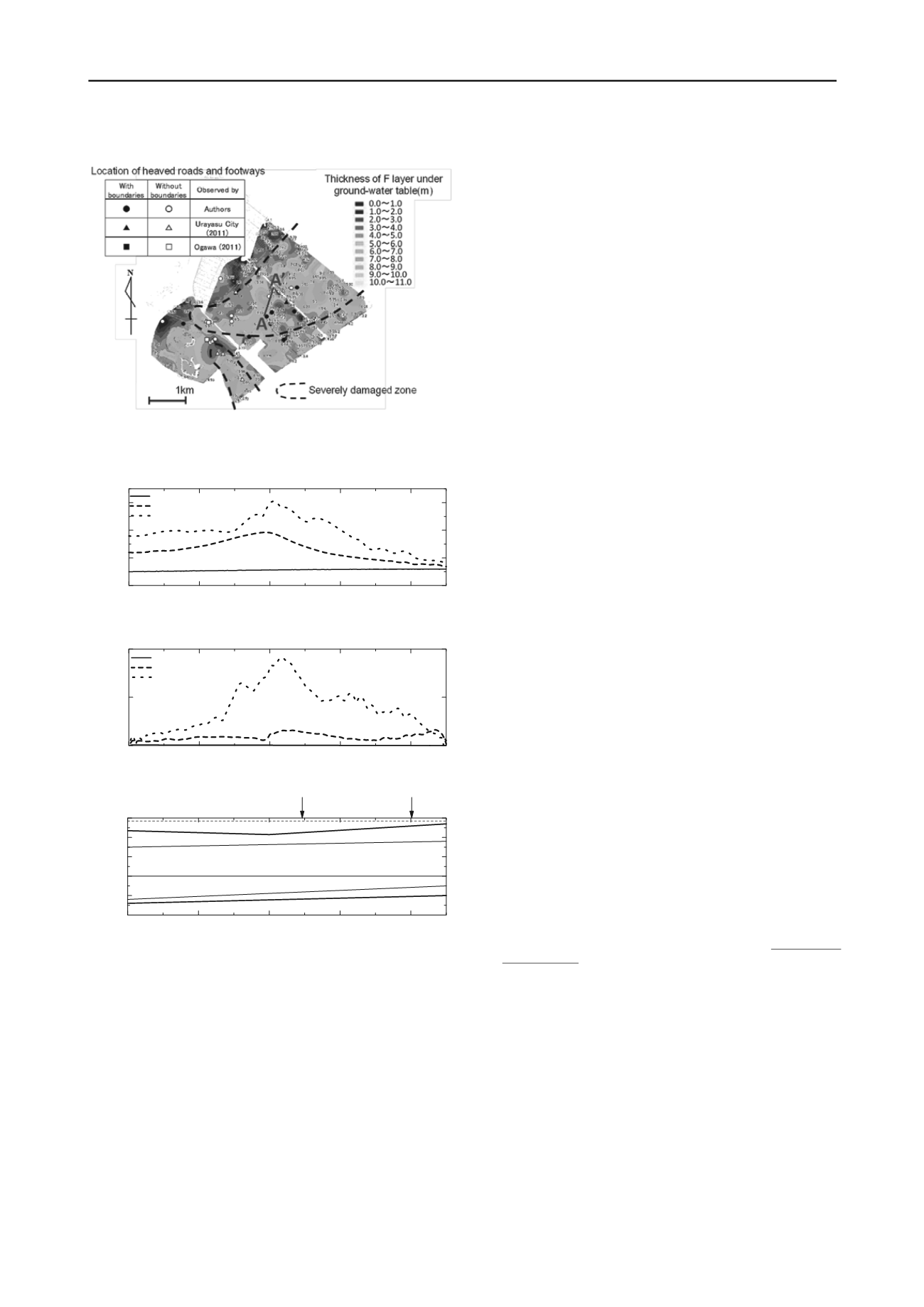
1662
Proceedings of the 18
th
International Conference on Soil Mechanics and Geotechnical Engineering, Paris 2013
boundaries, are plotted in Figure 14. By comparing the locations
of heaved footways and alleys without boundaries with the
contour lines of the thickness of the dredged and filled (F) layer
under the ground water table, it is seen that heaving occurred at
sites where the bottom of the dredged and filled layer, in other
words, the liquefied layer, was sloped. This implies that a kind
of horizontal buckling of the surface layer might have occurred
due to the concentration of horizontal compressive stress, as
schematically shown in Figure 13 (2).
Seismic response analyses were carried out to estimate the
concentration of horizontal compressive strain along line A-A’
in Figure 14. Figure 15 (3) shows the soil cross section along
line A-A’. In the analyses the “FLUSH” software program was
used. The shear modulus in small strain,
G
0
was estimated form
SPT
N
-values, and the
G
/
G
0
–
γ
and the
h
–
γ
relationships
were estimated by the relationship proposed by Yasuda and
Yamaguchi (1985). However, for the dredged and filled layer,
G
0
was reduced to 1/50 and 1/100 to consider the effect of
liquefaction, and
G
0
was assumed to be constant regardless of
shear strain
γ
. Many seismic records were obtained from the
ground surface and from underground during the earthquake. Of
these, the seismic wave recorded at Yumeno-shima, shown in
Figure 1, was used for the analysis. Figures 15 (1) and 15 (2)
show the distribution of the maximum horizontal displacement
and compressive strain of the soil, respectively, at the depth of
GL-1.5m. As shown in Figure 15 (2), large compressive strain
is estimated to have been induced near the site where the thrust
of a road occurred.
Many sewage manholes were cracked and sheared in a
horizontal direction and filled with muddy water, whereas a few
manholes were lifted or slightly settled in Urayasu City. The
large horizontal displacement of liquefied ground had to cause
the disconnection of pipe joints and the shear failure of the
manholes, allowing the influx of muddy water into the pipes
and manholes.
Figure 14 Estimated thickness of dredged and filled layer under water
table (Quoted from the report by the Technical Committee organized
by Urayasu City, 2012) and locations of heaved roads and footways
5 CONCLUSION
Laboratory tests, model tests and seismic response analyses
were carried out to explain the remarkable behavior of the
ground due to liquefaction in the Tokyo Bay area during the
2011 Great East Japan Earthquake, and the followings
conclusions were derived:
(1) Seismic intensities in the liquefied zones were not high, with
peak surface accelerations of 160 to 300 cm/s
2
, though the
liquefied ground was covered with boiled sands. The very long
duration of the main shock and an aftershock 29 minutes later
should have induced the severe liquefaction.
(2) It is estimated that much eruption of sands and large ground
subsidence occurred because the liquefied soil had much fines
and was easily lifted above the ground surface by the ejecting
water.
(3) A kind of horizontal buckling of the surface layer might
have occurred due to the concentration of horizontal
compressive strain of liquefied ground and caused the strange
heaving, buckling or thrust of the footways and alleys.
6 REFERENCES
Japan Road Association 1996. Specification for highway bridges. (in
Japanese).
Kanto Regional Development Bureau of the Ministry of Land,
Infrastructure, Transport and Tourism 2011. Study on the
liquefaction in Kanto Region during the Tohoku-Pacific Ocean
earthquake. (in Japanese)
National Research Institute for Earth Science and Disaster Prevention
(NIED). K-NET WWW service, Japan
-
net.bosai.go.jp/).
Urayasu City. 2012. Report on measures against liquefaction in Urayasu
City, (in Japanese)
Yasuda, S. and Yamaguchi, I. 1985. Dynamic soil properties of
undisturbed samples.
P
roc.
of the 20
th
Japan National Conf. on
SMFE
,539-542. (in Japanese)
Yasuda, S. 2009. Estimation of earthquake-triggered flood in a subsided
area,
Proc. of the 17
th
International Conference on Soil Mechanics
& Geotechnical Engineering
, 1686-1689.
Yasuda S., Harada K., Ishikawa K. and Kanemaru Y. 2012.
Characteristics of the Liquefaction in Tokyo Bay Area by the 2011
Great East Japan Earthquake.
Soils and Foundations
, (in printing)
Figure 15. Results of seismic response analyses to estimate the
concentration of horizontal compressive strain
(1) Maximum horizontal displacement
(2) Maximum compressive strain
(3) Soil cross section along A-A’ line
0
200
400
600
800
0
20
40
60
G
0
was not reduced
G
0
was reduced to 1/50
G
0
was reduced to 1/100
Maximum horizontal
displacement(cm)
distance(m)
1
0
200
400
600
800
0
0.5
G
0
was not reduced
G
0
was reduced to 1/50
G
0
was reduced to 1/100
Maximum strain(%)
distance(m)
50
0
200
400
600
800
0
10
20
30
40
distance(m)
Height(m
Clay
Sand
Clay
Alluvial layer
Diluvial layer
)
F
(
Liquefied layer
)
Sand
A
A'
Thrust of a roads


